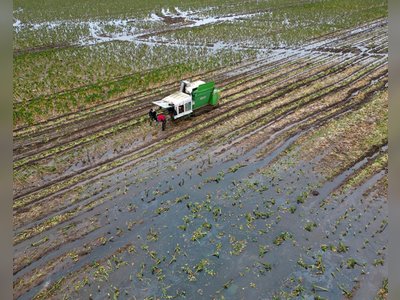
Don’t Be Surprised When Vaccinated People Get Infected
Post-immunization cases, sometimes called “breakthroughs,” are very rare and very expected.
It’s hard to know when exactly the first cases appeared. But certainly by January’s end, a slow trickle of post-vaccination infections had begun in the United States. They arose in the West, making headlines in Oregon; they sprouted in the Midwest and the South. Some of the latest reports have come out of Florida, Texas, and Hawaii. These breakthrough cases—discovered in people more than two weeks after they received their final COVID-19 shot—will continue to grow in number, everywhere. And that’s absolutely no cause for concern.
Breakthrough infections, which occur when fully vaccinated people are infected by the pathogen that their shots were designed to protect against, are an entirely expected part of any vaccination process. They’re the data points that keep vaccines from reaching 100 percent efficacy in trials; they’re simple proof that no inoculation is a perfect preventative. And so far, the ones found after COVID-19 vaccination seem to be unextraordinary.
Since mid-December, when the rollout of the newly authorized vaccines began, nearly 40 million Americans have received the jabs they need for full immunization. A vanishingly small percentage of those people have gone on to test positive for the coronavirus. The post-shot sicknesses documented so far seem to be mostly mild, reaffirming the idea that inoculations are powerful weapons against serious disease, hospitalization, and death. This smattering of cases is a hazy portent of our future: Coronavirus infections will continue to occur, even as the masses join the ranks of the inoculated. The goal of vaccination isn’t eradication, but a détente in which humans and viruses coexist, with the risk of disease at a tolerable low.
When breakthrough cases do arise, it’s not always clear why. The trio of vaccines now circulating in the United States were all designed around the original coronavirus variant, and seem to be a bit less effective against some newer versions of the virus. These troublesome variants have yet to render any of our current vaccines obsolete. But “the more variants there are, the more concern you have for breakthrough cases,” Saad Omer, a vaccine expert at Yale, told me. The circumstances of exposure to any version of the coronavirus will also make a difference. If vaccinated people are spending time with groups of unvaccinated people in places where the virus is running rampant, that still raises their chance of getting sick. Large doses of the virus can overwhelm the sturdiest of immune defenses, if given the chance.
The human side of the equation matters, too. Immunity is not a monolith, and the degree of defense roused by an infection or a vaccine will differ from person to person, even between identical twins. Some people might have underlying conditions that hamstring their immune system’s response to vaccination; others might simply, by chance, churn out fewer or less potent antibodies and T cells that can nip a coronavirus infection in the bud.
The effects of vaccination are best considered along a spectrum, says Ali Ellebedy, an immunologist at Washington University in St. Louis. An ideal response to vaccination might create an arsenal of immune molecules and cells that can instantaneously squelch the virus, leaving no time for symptoms to appear. But sometimes that front line of fighters is relatively sparse. Should the virus make it through, “it becomes a race [against] time,” Ellebedy told me. The pathogen rushes to copy itself, and the immune system recruits more defenders. The longer the tussle drags on, the more likely the disease is to manifest.
The range of vaccine responses “isn’t a variation of two- to threefold; it’s thousands,” Ellebedy told me. “Being vaccinated doesn’t mean you are immune. It means you have a better chance of protection.”
For these reasons and more, Viviana Simon, a virologist at the Icahn School of Medicine at Mount Sinai, in New York, dislikes the term breakthrough case, which evokes a barrier walling humans off from disease. “It’s very misleading,” she told me. “It’s like the virus ‘punches’ through our defenses.”
Vaccination is actually more like a single variable in a dynamic playing field—a layer of protection, like an umbrella, that might guard better in some situations than others. It could keep a lucky traveler relatively dry in a light drizzle, but in a windy maelstrom that’s whipping heavy droplets every which way, another person might be overwhelmed. And under many circumstances, vaccines are still best paired with safeguards such as masks and distancing—just as rain boots and jackets would help buffer someone in a storm.
In some ways, the shots’ staggering success in trials—where breakthrough cases were also observed, causing appropriately minimal stir—may have papered over the inevitability of post-vaccination infections in more natural settings. “The vaccines exceeded expectations,” Luciana Borio, a former acting chief scientist at the FDA, told me. Now, as we exit what Borio calls the “honeymoon phase” of our relationship with the jabs, we need to temper our enthusiasm with the right amount of realism, especially as more data on the shots’ strength and longevity accumulate. Even excellent vaccines aren’t foolproof, and they shouldn’t be criticized when they’re not. “We can’t expect it’s going to be perfect, on day one, always,” Borio said.
Breakthrough cases also include asymptomatic infections, according to the CDC's current definition—which is different from the criteria on which the vaccines were originally judged. In clinical trials, the three vaccines cleared for emergency use in the United States were evaluated for their ability to prevent symptomatic cases of COVID-19, which they each do to a remarkably high extent. The Moderna and Pfizer-BioNTech jabs reduce, on a population scale, the risk of disease by about 95 percent; Johnson & Johnson’s clocked in at 72 percent among Americans.
The numbers for asymptomatic infections are still crystallizing, but they’re likely to be lower. Purging a virus before sickness sets in is a higher bar for the immune system to clear. “The trick is to distinguish between infection and disease,” Simon told me. “Whenever someone tests positive, the real question is, are they sick, and how sick are they? That’s a big difference.”
Efficacy, a figure specific to clinical trials, also doesn’t always translate perfectly to the messiness of the real world, where there’s immense variability in how, when, where, by whom, and to whom shots are administered. The vaccine’s performance under these conditions is tracked by a separate measure, called effectiveness. Studies rigorously examining vaccine effectiveness are challenging, but early data suggest that the Pfizer-BioNTech and Moderna shots are living up to their initial hype.
The number of post-vaccination infections is also contingent on “the ongoing transmission situation,” Omer told me. “It depends on how much people are mixing.” A vaccine with a recorded efficacy of 95 percent, for example, doesn’t give everyone who’s vaccinated a 5 percent chance of getting sick. Not all of those people will even encounter the virus. The key is how vaccination changes the outcome for those who are meaningfully exposed: Among 100 individuals who might have fallen ill without the vaccine, just five symptomatic cases might appear.
A team at the CDC is tracking breakthroughs and will soon start reporting case counts, as well as any patterns related to where, or in whom, these infections are occurring, Martha Sharan, a CDC spokesperson, told me. Details like those matter. They can help experts figure out why post-vaccination infections happen, and how they might be stopped. “The reassuring part is, these cases will not go unnoticed,” Omer told me.
Most of the time, vaccines are far more likely to offer some help than none. Serious disease, hospitalization, and even death will still occur, as will less well-studied outcomes, such as the long-term symptoms that often arise from less severe disease. But should post-vaccination infections climb to unexpectedly high rates, backup plans will quickly kick into gear. Some shot recipients might get second or third shots to bolster their immune response; others might be administered a tweaked vaccine recipe to account for a new viral variant.
There’s something a touch counterintuitive about breakthrough cases: The more people we vaccinate, the more such cases there will be, in absolute numbers. But the rate at which they appear will also decline, as rising levels of population immunity cut the conduits that the virus needs to travel. People with lackluster responses to vaccines—as well as those who can’t get their jabs—will receive protection from the many millions in whom the shots did work. In a crowd of people holding umbrellas, even those who are empty-handed will stay more dry.
Breakthrough infections, which occur when fully vaccinated people are infected by the pathogen that their shots were designed to protect against, are an entirely expected part of any vaccination process. They’re the data points that keep vaccines from reaching 100 percent efficacy in trials; they’re simple proof that no inoculation is a perfect preventative. And so far, the ones found after COVID-19 vaccination seem to be unextraordinary.
Since mid-December, when the rollout of the newly authorized vaccines began, nearly 40 million Americans have received the jabs they need for full immunization. A vanishingly small percentage of those people have gone on to test positive for the coronavirus. The post-shot sicknesses documented so far seem to be mostly mild, reaffirming the idea that inoculations are powerful weapons against serious disease, hospitalization, and death. This smattering of cases is a hazy portent of our future: Coronavirus infections will continue to occur, even as the masses join the ranks of the inoculated. The goal of vaccination isn’t eradication, but a détente in which humans and viruses coexist, with the risk of disease at a tolerable low.
When breakthrough cases do arise, it’s not always clear why. The trio of vaccines now circulating in the United States were all designed around the original coronavirus variant, and seem to be a bit less effective against some newer versions of the virus. These troublesome variants have yet to render any of our current vaccines obsolete. But “the more variants there are, the more concern you have for breakthrough cases,” Saad Omer, a vaccine expert at Yale, told me. The circumstances of exposure to any version of the coronavirus will also make a difference. If vaccinated people are spending time with groups of unvaccinated people in places where the virus is running rampant, that still raises their chance of getting sick. Large doses of the virus can overwhelm the sturdiest of immune defenses, if given the chance.
The human side of the equation matters, too. Immunity is not a monolith, and the degree of defense roused by an infection or a vaccine will differ from person to person, even between identical twins. Some people might have underlying conditions that hamstring their immune system’s response to vaccination; others might simply, by chance, churn out fewer or less potent antibodies and T cells that can nip a coronavirus infection in the bud.
The effects of vaccination are best considered along a spectrum, says Ali Ellebedy, an immunologist at Washington University in St. Louis. An ideal response to vaccination might create an arsenal of immune molecules and cells that can instantaneously squelch the virus, leaving no time for symptoms to appear. But sometimes that front line of fighters is relatively sparse. Should the virus make it through, “it becomes a race [against] time,” Ellebedy told me. The pathogen rushes to copy itself, and the immune system recruits more defenders. The longer the tussle drags on, the more likely the disease is to manifest.
The range of vaccine responses “isn’t a variation of two- to threefold; it’s thousands,” Ellebedy told me. “Being vaccinated doesn’t mean you are immune. It means you have a better chance of protection.”
For these reasons and more, Viviana Simon, a virologist at the Icahn School of Medicine at Mount Sinai, in New York, dislikes the term breakthrough case, which evokes a barrier walling humans off from disease. “It’s very misleading,” she told me. “It’s like the virus ‘punches’ through our defenses.”
Vaccination is actually more like a single variable in a dynamic playing field—a layer of protection, like an umbrella, that might guard better in some situations than others. It could keep a lucky traveler relatively dry in a light drizzle, but in a windy maelstrom that’s whipping heavy droplets every which way, another person might be overwhelmed. And under many circumstances, vaccines are still best paired with safeguards such as masks and distancing—just as rain boots and jackets would help buffer someone in a storm.
In some ways, the shots’ staggering success in trials—where breakthrough cases were also observed, causing appropriately minimal stir—may have papered over the inevitability of post-vaccination infections in more natural settings. “The vaccines exceeded expectations,” Luciana Borio, a former acting chief scientist at the FDA, told me. Now, as we exit what Borio calls the “honeymoon phase” of our relationship with the jabs, we need to temper our enthusiasm with the right amount of realism, especially as more data on the shots’ strength and longevity accumulate. Even excellent vaccines aren’t foolproof, and they shouldn’t be criticized when they’re not. “We can’t expect it’s going to be perfect, on day one, always,” Borio said.
Breakthrough cases also include asymptomatic infections, according to the CDC's current definition—which is different from the criteria on which the vaccines were originally judged. In clinical trials, the three vaccines cleared for emergency use in the United States were evaluated for their ability to prevent symptomatic cases of COVID-19, which they each do to a remarkably high extent. The Moderna and Pfizer-BioNTech jabs reduce, on a population scale, the risk of disease by about 95 percent; Johnson & Johnson’s clocked in at 72 percent among Americans.
The numbers for asymptomatic infections are still crystallizing, but they’re likely to be lower. Purging a virus before sickness sets in is a higher bar for the immune system to clear. “The trick is to distinguish between infection and disease,” Simon told me. “Whenever someone tests positive, the real question is, are they sick, and how sick are they? That’s a big difference.”
Efficacy, a figure specific to clinical trials, also doesn’t always translate perfectly to the messiness of the real world, where there’s immense variability in how, when, where, by whom, and to whom shots are administered. The vaccine’s performance under these conditions is tracked by a separate measure, called effectiveness. Studies rigorously examining vaccine effectiveness are challenging, but early data suggest that the Pfizer-BioNTech and Moderna shots are living up to their initial hype.
The number of post-vaccination infections is also contingent on “the ongoing transmission situation,” Omer told me. “It depends on how much people are mixing.” A vaccine with a recorded efficacy of 95 percent, for example, doesn’t give everyone who’s vaccinated a 5 percent chance of getting sick. Not all of those people will even encounter the virus. The key is how vaccination changes the outcome for those who are meaningfully exposed: Among 100 individuals who might have fallen ill without the vaccine, just five symptomatic cases might appear.
A team at the CDC is tracking breakthroughs and will soon start reporting case counts, as well as any patterns related to where, or in whom, these infections are occurring, Martha Sharan, a CDC spokesperson, told me. Details like those matter. They can help experts figure out why post-vaccination infections happen, and how they might be stopped. “The reassuring part is, these cases will not go unnoticed,” Omer told me.
Most of the time, vaccines are far more likely to offer some help than none. Serious disease, hospitalization, and even death will still occur, as will less well-studied outcomes, such as the long-term symptoms that often arise from less severe disease. But should post-vaccination infections climb to unexpectedly high rates, backup plans will quickly kick into gear. Some shot recipients might get second or third shots to bolster their immune response; others might be administered a tweaked vaccine recipe to account for a new viral variant.
There’s something a touch counterintuitive about breakthrough cases: The more people we vaccinate, the more such cases there will be, in absolute numbers. But the rate at which they appear will also decline, as rising levels of population immunity cut the conduits that the virus needs to travel. People with lackluster responses to vaccines—as well as those who can’t get their jabs—will receive protection from the many millions in whom the shots did work. In a crowd of people holding umbrellas, even those who are empty-handed will stay more dry.











